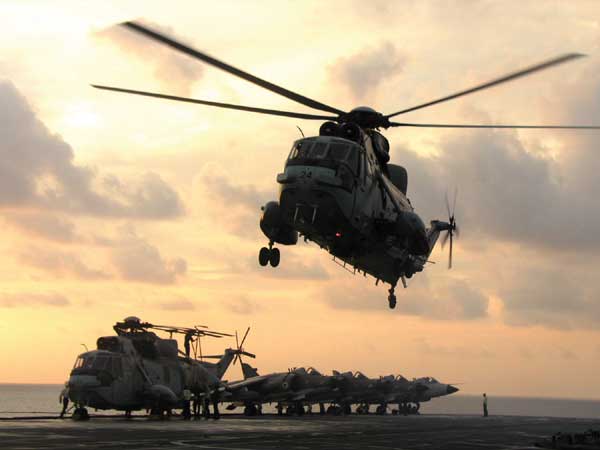India with its geography sits as one of the most strategically located nation especially in the Asian context. It has a 2.4 percentage share of the world’s total landmass. It consists of almost 1,320 island territories covering both its flanks. Having a maritime boundary of 7,500 Km and an Exclusive Economic Zone (EEZ) worth 2.37 million square km (about twice the area of Egypt) extending in Arabian sea, Indian Ocean, the Bay of Bengal and the Andaman Sea overlooking Malacca Straits. The importance of economic and strategic takeaway is unmistakable. The region contributes almost 50 percent of the world’s oil trade, about 90,000 commercial liners pass through it every year. It is expected that region will account for 20 percent of world’s GDP by 2025.
India’s Western theatre is dotted by major regional players, shadow nuclear powers, most hostile neighbours and non-state actors.
This also been the reason for India’s historical connect with many ancient civilisations including Mesopotamia, Egypt, Greco-Roman, and Indo-Persian civilisations. Indian Navy since its evolution has undergone multiple make over from being part of British Royal Navy to the Naval force of Independent India. It boasts of a glorious history with major operations like the capture of Massawa from the Italians in April 1941 and most significant being Op Trident on 04th Dec 1971, when it attacked Karachi harbour and sank multiple frontline warships of Pakistan. The day apart from being etched in history of Indian Navy’s most outstanding achievement is also a constant reminder of the continued challenge it presents in formulation of Indian Navy’s operational role for the Western front.
Simmering Hostilities
India’s Western theatre is dotted by major regional players, shadow nuclear powers, most hostile neighbours and non-state actors. Majority of countries surrounding the Indian Ocean and Arabian Sea have been part of such upheavals themselves on one time or the other. India, Pakistan, Iran, Saudi Arabia, Iraq, Kuwait, Yemen, and Egypt all these regional players have been at odds with each other due to differing national narratives often leading to simmering hostilities or the outright wars.
The history often has a penchant for repeating itself in some form, as the complex relations aggravated these regional players started choosing allies between cold war rivals US and Soviets even French and British found favours to step in the regional conflicts many a times on the ‘request’ of host governments. The powers which have been singularly responsible for creating this deep divide between nations during their fading days of colonialism, were again in the region, this time trying to ‘sort out’ distrusts. It couldn’t have been more flawed than this.
Since 1970 onwards India went on to gradually improve its naval force with acquisitions of submarines, deployment of numerous warships…
These developments led to situations wherein, the British government responsible for November 1917 declaration, for establishment of a “national home for the Jewish people” were also seen advocating for Palestinian rights; champion of democracy, the US, cozying up with West Asian monarchs; and the NATO, an exclusive European security alliance as per it’s charter, fighting with all its military might in the Gulf and Afghan wars. These wars were fought with predominant and massive naval component not witnessed in the history till then.
India As Resident Power
These offshore developments were not lost on India which was keeping a scrutiny of changing dynamics. India had the advantage of its geography, history and the demographical deep connect with the region. It has had major naval presence in the waters of Indian Ocean and Arabian sea. Since 1970 onwards India went on to gradually improve its naval force with acquisitions of submarines, deployment of numerous warships and it’s only aircraft carrier INS Vikramaditya augmenting it’s projection of power covering the entire stretch from the Horn of Africa to its Western shores.
Indian Navy at any given time has around one aircraft carrier on operational readiness, a dozen of frigates and destroyers, an amphibious transport craft, almost 18 submarines, multiple corvettes and landing crafts with majority deployed in the Western theatre. It has mutual logistics support pact with US, UK and France giving it access to logistics from British Indian Ocean Territories and French Islands territories in the region. India has deployed deep water assets capable of operating and patrolling the high seas from weeks to months. It has indicated its plans to have naval base beyond its boundary and is probably close to operationalise one. It has deployed nearly 50 warships around the Gulf of Aden which actively operates in piracy-prone areas.
Geopolitical Changes
In the last decade the region has witnessed major geopolitical changes and alteration of security dynamics. The question of Iran going nuclear or not has been a seesaw with US playing cat and mouse. Sanctions, IAEA inspections and unilateral withdrawal from the nuclear deal by the US in 2018. Syria has been a classic case of how external influences can implode a country. Libya, Lebanon and Yemen went through the civil war and has intensely competing domestic politics. China’s aggressive foray has coincided with wanning US influence in the region, especially post Xi Jinping’s presidency. Xi’s flagship Belt & Road Initiative has seen major Chinese investments being pumped in the region for infrastructure and connectivity. This was doubled up with gradual increase in movement of Chinese naval ships.
China’s interest in expanding its global influence was riding high with its business deals.
China continued increasing its naval presence in the garb of securing BRI interests often running afoul of established partnerships. Prime example being Indo-Maldivian relationship, where Maldives got trapped with Chinese manipulation in its domestic polity. China’s interest in expanding its global influence was riding high with its business deals. It was among first to open communications with Taliban post US withdrawal (recently China has become the first country to have accepted Afghanistan’s Ambassador), it worked with Iran to give them succor as they continued to confront US conditions for reconciliatory approach towards their nuclear deal.
China’s growing interest are backed up by planned capacity buildup for PLA Navy, from 370 ships presently it is aiming to grow to 440 ships by 2030. A study by US Think Tank, Atlantic Council in August 2023 has highlighted how – “Beijing has long been interested in expanding its operations into the IOR as part of a unified hybrid strategy to protect its growing economic and security interests in the region”. If the rapid rise of PLA Navy has been concerning, the quick deployment of six Chinese warships around the Israeli waters during ongoing Hamas-Israel conflict was alarming. It was for the first time that Chinese have chosen to operationally deploy its warships around the conflict zone in the Indian Ocean.
First Responder
Indian Navy needs to do some spade work in continuing its visibility and effectively dominate its Western waters. The aggressive foray of PLA Navy and its desire to box India around appears to have complicated the environment. Indian Navy as a first responder for national maritime security, should look to work on multiple tactical and technical aspects. This includes – capacity build-up, enhanced coordination with friendly navies, exploring avenues for more offshore bases, capability augmentation especially towards underwater unmanned surveillance & amphibious operations. Technical advancements in highly secure communications and interoperability for functioning in an integrated and multi-domain networked environment and maintaining enlarged presence for quick response.
ndian Navy needs to be mindful and must continue its endeavour to be in a position for quickly integrating with other powers…
These signaling were also noticed in India’s Chief of Naval Staff (CNS) Admiral Hari Kumar’s address during the Goa Maritime Conclave held last month. His four principal assertions were in sync with the current geopolitical realities. CNS asserted India’s willingness – to take lead in capacity building; to leverage unique capabilities and expertise of each member states; to establish regional Centers of Excellence and to prioritise the efforts. All these exertions are aimed at retaining India’s key role of being “net security provider” in its Western theatre.
While the Indian Navy resolutely pursues all these endeavours, an isolated approach to such a dynamic challenge is unlikely to give it expected dividend. Current security challenges and the operational restrictions imposed due to strategic considerations demand an enlarged vision. Indian Navy needs to be mindful and must continue its endeavour to be in a position for quickly integrating with other powers, it’s participation in multilateral security arrangements like Indian Ocean Rim Association is one such scenario.
There are various positives which will aid Indian Navy in the path it pursues, the goodwill and the gun powder it carries both will be significant. China may have been engineering complications like Maldives episode, but this will remain a temporary situation for a politically polarised nation. China should remain careful, there are more players for the game it is trying to play. The PLA Navy is attempting to squeeze itself into highly contested waters with very limited mutual support and far off from its mainland. On the contrary Indian Navy
operates in its own backwaters with much bigger operational latitude. With US and Western powers breathing down in South and East China seas, PLA Navy hold restricted resource to divert them towards Indian Ocean. It will none-the-less remain some very demanding work ahead for the Indian Navy with little margin for slippages!





